
Handbook of Neurosurgery, Neurology, and Spinal Medicine for Nurses and Advanced Practice Health Professionals (eBook, ePUB)

PAYBACK Punkte
34 °P sammeln!
This practical handbook allows nurses, advanced practice nurses, physician assistants, and allied health professionals practicing in the fields of neurosurgery, neurology, and spinal care to quickly review essentials while in the work environment. It emphasizes procedural steps and critical elements in patient management, including intensive care, the neurological examination, differential diagnoses, and pain management. Written by a multidisciplinary team of experts, the handbook is expected to become a well-worn companion and essential aid to the busy practitioner.
Dieser Download kann aus rechtlichen Gründen nur mit Rechnungsadresse in A, B, BG, CY, CZ, D, DK, EW, E, FIN, F, GR, HR, H, IRL, I, LT, L, LR, M, NL, PL, P, R, S, SLO, SK ausgeliefert werden.













